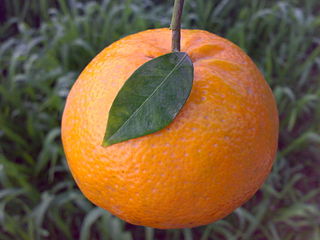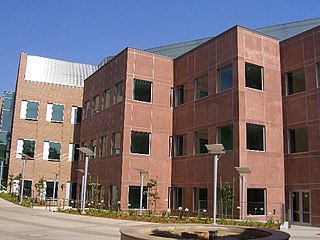
The UCR Citrus Variety Collection (CVC) is one of the most important collections of citrus diversity in the world. It is used for research, plant breeding, and educational extension activities on the UC Riverside campus in Riverside, California.

The UCR Citrus Variety Collection (CVC) is one of the most important collections of citrus diversity in the world. It is used for research, plant breeding, and educational extension activities on the UC Riverside campus in Riverside, California.
The collection is composed of over 1000 accessions, planted as two trees of each of various types of citrus and citrus relatives. The collection largely comprises accessions within the genus Citrus, the remaining types are included among 28 other related genera in the Rutaceae subfamily Aurantioideae.
The collection consists of approximately 25 acres (10 ha) on the UCR campus, 2 acres (0.81 ha) at the South Coast Research and Extension Center in Irvine, California, and 2 acres (0.81 ha) at the Coachella Valley Agricultural Research Station in Thermal, California. It includes accessions that were first introduced in the early 20th century, as well as varieties brought in over time from various curators, and newer varieties that were more recently developed by breeding or brought in as material through the Citrus Clonal Protection Program (CCPP), a special program that evaluates the trees for the nursery and citrus industries.
The CVC was first established with approximately 500 species of citrus planted on 5 acres (2.0 ha) by Herbert John Webber, professor of plant breeding and director of the early UC Citrus Experiment Station.
The collection currently serves as a genetic resource for research and breeding. Other research being conducted in the collection ranges from subjects related to entomology, nematology, microbiology, plant pathology, soil science, and metabolomics. In addition, the USDA-ARS National Clonal Germplasm Repository for Citrus and Dates (NCGRCD) uses the collection for the conservation of genetic diversity within the family Rutaceae.
The collection is one of the most diverse citrus germplasm collections. Aside from its foundations of supporting research, the collection also supports educational tours and extension activities through the University of California, Riverside.
David Karp photographed the fruit and trees of the CVC, which are placed on the web by Toni Siebert.

A clementine is a tangor, a citrus fruit hybrid between a willowleaf mandarin orange and a sweet orange, named in honor of Clément Rodier, a French missionary who first discovered and propagated the cultivar in Algeria. The exterior is a deep orange colour with a smooth, glossy appearance. Clementines can be separated into 7 to 14 segments. Similar to tangerines, they tend to be easy to peel. They are typically juicy and sweet, with less acid than oranges. Their oils, like other citrus fruits, contain mostly limonene as well as myrcene, linalool, α-pinene and many complex aromatics.

The University of California, Riverside is a public land-grant research university in Riverside, California. It is one of the ten campuses of the University of California system. The main campus sits on 1,900 acres (769 ha) in a suburban district of Riverside with a branch campus of 20 acres (8 ha) in Palm Desert. In 1907, the predecessor to UCR was founded as the UC Citrus Experiment Station, Riverside which pioneered research in biological pest control and the use of growth regulators.

The University of California, Riverside, Botanic Gardens are 40 acres of botanical gardens containing more than 3,500 plant species from around the world. The Gardens are located in the eastern foothills of the Box Springs Mountain on the University of California, Riverside campus in Riverside, California, US. Over four miles (6 km) of trails wind through many microclimates and hilly terrain.

Herbert John Webber was an American plant physiologist, professor emeritus of sub-tropical horticulture, first director of the University of California Citrus Experiment Station, and the third curator of the University of California Citrus Variety Collection. Webber was the author of several publications on horticulture, member of numerous professional horticultural and agricultural associations. He coined the word "clone" in 1903 and was the first to use it to describe a colony of organisms derived asexually from a single progenitor.

Citropsis is a genus of flowering plants in the citrus family, Rutaceae. They are known generally as African cherry oranges. They are native to Africa.
The history of the University of California, Riverside, or UCR, started in 1907 when UCR was the University's Citrus Experiment Station. By the 1950s, the University had established a teaching-focused liberal arts curriculum at the site, in the spirit of a small liberal arts college, but California's rapidly growing population made it necessary for the Riverside campus to become a full-fledged general campus of the UC system, and it was so designated in 1959.

The Kinnow is a high yield mandarin hybrid cultivated extensively in the wider Punjab region of India and Pakistan.
The University of California Citrus Experiment Station is the founding unit of the University of California, Riverside campus in Riverside, California, United States. The station contributed greatly to the cultivation of the orange and the overall agriculture industry in California. Established February 14, 1907, the station celebrated its 100th anniversary in 2007.

The College of Natural and Agricultural Sciences (CNAS) at the University of California, Riverside, is a nationally unique academic division in that it combines the physical, biological, mathematical and agricultural disciplines under one organizational umbrella. The college is organized into 13 academic departments: Biochemistry, Biology, Botany and Plant Sciences, Cell Biology and Neuroscience, Chemistry, Earth Sciences, Entomology, Environmental Sciences, Mathematics, Nematology, Physics, Plant Pathology and Microbiology, and Statistics.
Merrillia is a monotypic genus of flowering plants in the citrus family, Rutaceae, containing the single species Merrillia caloxylon. Its English language common names include flowering merrillia, katinga, and Malay lemon. In Malaysia it is called ketenggah and kemuning gajah. The species is native to Malaysia, Thailand, and Sumatra in Indonesia.
The false oranges are a group of flowering plants in the Citrus genus, within the family, Rutaceae. They are endemic to New Caledonia.

Cam sành or King orange is a citrus hybrid originating in Vietnam.
The main campus of the University of California, Riverside (UCR) is located within the city of Riverside in western Riverside County, three miles (5 km) east of downtown, and comprises 1,112 acres (4.50 km2) bisected by the Interstate 215/State Route 60 freeway. Nearly half of the total area is devoted to agricultural teaching and research fields, most of which are located west of the freeway.
The California Institute for Water Resources was an interdisciplinary research institute dedicated to developing and coordinating a system-wide approach to water conservation. The center was funded by the California State Legislature in 1957, and was located on the original 1907 site of the UC Citrus Experiment Station on Mount Rubidoux in Riverside County, California. WRC was administered by the UC Division of Agriculture and Natural Resources (ANR). It collected historic and other documents related to water topics through the Water Resources Center Archives (WRCA) and made the collection available to the public.

The Yemenite citron is a variety of citron, usually containing no juice vesicles in its fruit's segments. The bearing tree and the mature fruit's size are somewhat larger than the trees and fruit of other varieties of citron.
Robert K. Soost was a citrus expert and professor of genetics at University of California, Riverside, and sixth curator of the University of California Citrus Variety Collection.

Clausena is a genus of flowering plants in the citrus family, Rutaceae. It was first defined by the Dutch botanist Nicolaas Laurens Burman in 1768. It is distributed in Africa, southern Asia, Australia, and the Pacific Islands.
Albert Etter (1872–1950) was an American plant breeder best known for his work on strawberry and apple varieties.
John Eliot Coit was an American professor specializing in the horticultural fields of avocado, citrus and carob, and second curator of University of California Citrus Variety Collection
Citrus rootstock are plants used as rootstock for citrus plants. A rootstock plant must be compatible for scion grafting, and resistant to common threats, such as drought, frost, and common citrus diseases.